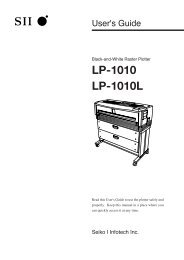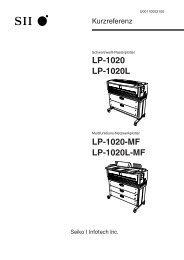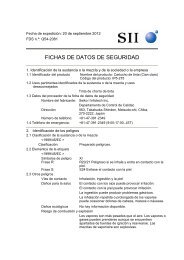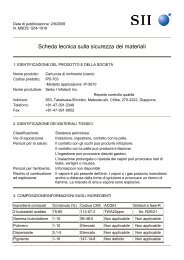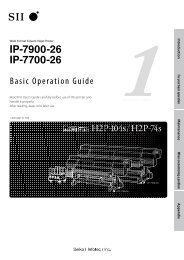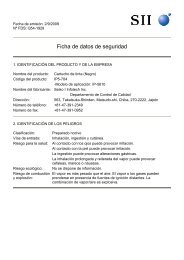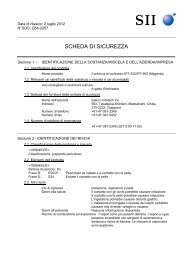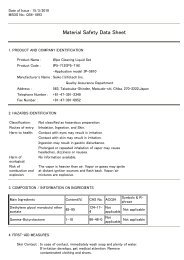Fiche technique de sécurité matériau - Seiko I Infotech Inc.
Fiche technique de sécurité matériau - Seiko I Infotech Inc.
Fiche technique de sécurité matériau - Seiko I Infotech Inc.
Create successful ePaper yourself
Turn your PDF publications into a flip-book with our unique Google optimized e-Paper software.
Date <strong>de</strong> publication : 2/10/2009<br />
MSDS N° : Q54-1946<br />
<strong>Fiche</strong> <strong>technique</strong> <strong>de</strong> sécurité matériau<br />
1. IDENTIFICATION DU PRODUIT ET DU FABRICANT<br />
Nom du produit :<br />
Co<strong>de</strong> produit :<br />
Nom du fabricant :<br />
Liqui<strong>de</strong> <strong>de</strong> nettoyage (6 pièces)<br />
IP6-139<br />
-Modèle <strong>de</strong> l'application : IP-6600/IP-6900<br />
<strong>Seiko</strong> I <strong>Infotech</strong> <strong>Inc</strong>.<br />
Département assurance qualité<br />
Adresse :<br />
563, Takatsuka-Shin<strong>de</strong>n, Matsudo-shi, Chiba, 270-2222, Japon<br />
Téléphone : +81-47-391-2349<br />
Télécopie : +81-47-391-0952<br />
2. IDENTIFICATION DES RISQUES<br />
Classification : Préparation nocive.<br />
Mo<strong>de</strong> <strong>de</strong> pénétration : Inhalation, ingestion et contact avec la peau.<br />
Nocivité pour la Le contact avec les yeux peut provoquer une irritation.<br />
santé :<br />
Le contact avec la peau peut provoquer une irritation.<br />
Nocivité pour<br />
l'environnement :<br />
Risque <strong>de</strong><br />
combustion et<br />
d'explosion :<br />
L'ingestion peut provoquer <strong>de</strong>s troubles gastriques.<br />
Une inhalation prolongée ou répétée <strong>de</strong>s vapeurs peut provoquer <strong>de</strong>s<br />
maux <strong>de</strong> tête, <strong>de</strong>s malaises ou <strong>de</strong>s nausées.<br />
Pas d'informations disponibles.<br />
Les vapeurs sont plus lour<strong>de</strong>s que l'air. Les vapeurs ou les gaz<br />
peuvent prendre feu à distance <strong>de</strong> sources inflammables et créer un<br />
retour <strong>de</strong> flamme. Le mélange vapeurs/air est explosif.
3. COMPOSITION / INFORMATIONS SUR LES INGRÉDIENTS<br />
Principaux ingrédients<br />
Acétate d'éther monobutylique<br />
d'éthylène glycol<br />
Contenu<br />
(en %)<br />
Nº CAS<br />
Symboles &<br />
phrases <strong>de</strong> risque<br />
90-100 112-07-2 Xn ; R20/21<br />
N-Méthyl-pyrrolidone
7. MANUTENTION ET STOCKAGE<br />
Manutention : Ne pas manipuler ni stocker le produit à proximité <strong>de</strong> flammes vives, <strong>de</strong><br />
sources <strong>de</strong> chaleur ou <strong>de</strong> sources inflammables. Utiliser uniquement dans<br />
un secteur bien aéré et porter l'équipement <strong>de</strong> protection adéquat pour<br />
éviter tout contact avec la peau ou les yeux et toute inhalation <strong>de</strong> vapeurs.<br />
Stockage : Stocker les conteneurs dans un emplacement sombre et frais. Veiller à ce que<br />
les conteneurs soient hermétiquement fermés.<br />
8. CONTRÔLE DE L'EXPOSITION / PROTECTION DES PERSONNES<br />
Limites d'exposition :<br />
Acétate d'éther monobutylique d'éthylène glycol ACGIH (TWA) : 20 ppm<br />
N-Méthyl-pyrrolidone<br />
ACGIH (TWA) : Non établi<br />
Contrôles d'ingénierie : Utiliser la ventilation locale d'évacuation.<br />
Protection du système respiratoire : Masque respiratoire pour éviter l'inhalation <strong>de</strong>s vapeurs <strong>de</strong><br />
solvants organiques.<br />
Protection <strong>de</strong>s mains : Porter <strong>de</strong>s gants résistants aux agents chimiques.<br />
Protection <strong>de</strong>s yeux : Utiliser <strong>de</strong>s lunettes étanches ou <strong>de</strong> protection.<br />
Protection <strong>de</strong> la peau : Porter <strong>de</strong>s vêtements <strong>de</strong> travail.<br />
Autre protection : Ne pas fumer, boire ou manger sur le lieu <strong>de</strong> travail.<br />
9. PROPRIÉTÉS PHYSIQUES ET CHIMIQUES<br />
Aspect :<br />
O<strong>de</strong>ur :<br />
Point d'ébullition :<br />
Point <strong>de</strong> fusion :<br />
Point d'éclair :<br />
Température<br />
d'auto-inflammation :<br />
Limite d'inflammabilité :<br />
Gravité spécifique :<br />
Pression <strong>de</strong> vapeur :<br />
Densité <strong>de</strong> vapeur :<br />
Solubilité dans l'eau :<br />
Dans l'eau :<br />
Pénétration eau :<br />
Liqui<strong>de</strong> transparent<br />
O<strong>de</strong>ur <strong>de</strong> solvant.<br />
>191°C (acétate d'éther monobutylique d'éthylène glycol)<br />
>-64,6°C (acétate d'éther monobutylique d'éthylène glycol)<br />
74,0 o C (coupe fermée Tag)<br />
270°C (N-Méthyl-pyrrolidone)<br />
Limite inférieure 0,8 vol % (acétate d'éther monobutylique d'éthylène<br />
glycol)<br />
Limite supérieure 8,5 vol % (acétate d'éther monobutylique<br />
d'éthylène glycol)<br />
0,96-1,00 g/cm 3 (25°C)<br />
3,4 (N-Méthyl-pyrrolidone) (Air=1)<br />
1,1 wt % (20°C) (acétate d'éther monobutylique d'éthylène glycol)<br />
Facilement soluble (N-Méthyl-pyrrolidone)<br />
1,6 wt % (20°C) (acétate d'éther monobutylique d'éthylène glycol)
10. STABILITÉ ET RÉACTIVITÉ<br />
Stabilité :<br />
Matériaux à éviter :<br />
Conditions à éviter :<br />
Réactions dangereuses :<br />
Produits <strong>de</strong><br />
décomposition :<br />
Stable<br />
Aci<strong>de</strong>s et agents oxydants<br />
Températures extrêmement élevées<br />
Sans objet<br />
Pas <strong>de</strong> données disponibles<br />
11. INFORMATIONS DE TOXICOLOGIE<br />
Toxicité aiguë<br />
Acétate d'éther monobutylique d'éthylène glycol Toxicité par voie orale LD 50 (rat) 2 400 mg/kg 1)<br />
Toxicité pour la peau LD 50 (lapin) 1 500 mg/kg 1)<br />
N-Méthyl-pyrrolidone Toxicité par voie orale LD 50 (rat) 4 200 mg/kg 2)<br />
Toxicité pour la peau LD 50 (marmotte) >8 000 mg/kg 2)<br />
Potentiel cancérigène : N-Méthyl-pyrrolidone : Affiche un résultat négatif pour le test d'exposition<br />
suivant.<br />
Inhalation (rat) 0 mg/L (0 ppm), 0,04 mg/L (10 ppm), 0,4 mg/L (99 ppm),<br />
6h/jour, 5j/semaine, 2 ans<br />
Potentiel mutagène : Pas d'informations disponibles.<br />
Autres informations sur la toxicité : Pas d'informations disponibles.<br />
12. INFORMATIONS ÉCOLOGIQUES<br />
Impact sur l'environnement et dispersion : Ce produit est partiellement soluble dans l'eau. Traiter<br />
à l'ai<strong>de</strong> <strong>de</strong>s <strong>technique</strong>s disponibles les plus avancées pour éviter toute contamination <strong>de</strong><br />
l'environnement.<br />
Toxicité : Pas d'informations disponibles.<br />
Effet sur le traitement <strong>de</strong>s eaux usées : Pas <strong>de</strong> données disponibles<br />
13. CONSIDÉRATIONS DE MISE AU REBUT<br />
Se conformer à l'ensemble <strong>de</strong>s réglementations nationales,<br />
régionales et locales.<br />
Éviter tout rejet dans les égouts, le sol ou tout milieu aquatique.<br />
14. INFORMATIONS RELATIVES AU TRANSPORT<br />
CLASSE D'UN : Sans objet<br />
NUMÉRO D'UN : Sans objet<br />
GROUPE D'EMBALLAGE : Sans objet<br />
NOM D'EXPÉDITION CORRECT : Encre<br />
Classification : Ce produit n'est pas classé comme dangereux pour le transport.<br />
Se conformer à toutes les réglementations en vigueur dans votre pays.
15. INFORMATIONS LÉGALES<br />
Tous les ingrédients <strong>de</strong> ce produit sont notifiés dans l'EINECS, ou exempts <strong>de</strong> notification.<br />
Classification : Préparation nocive.<br />
Indication <strong>de</strong> danger : Nocif<br />
Symbole <strong>de</strong> risque : Xn<br />
Phrase <strong>de</strong> R20/21 Nocif en cas d'inhalation et <strong>de</strong> contact avec la peau.<br />
risque :<br />
R36/38 Irritant pour les yeux et la peau.<br />
Phrase <strong>de</strong> S24 Éviter tout contact avec la peau.<br />
sécurité :<br />
S41 En cas d'incendie et/ou d'explosion, ne pas inhaler les<br />
fumées.<br />
Se conformer à toutes les réglementations en vigueur dans votre pays<br />
16. AUTRES INFORMATIONS<br />
Cette fiche <strong>de</strong> données <strong>technique</strong>s a été préparée en conformité avec la directive 2001/58/EEC.<br />
Les informations ci-<strong>de</strong>ssus se réfèrent à la sécurité <strong>de</strong>s produits désignés, sur la base <strong>de</strong>s<br />
données les plus récentes connues. Toute responsabilité est déclinée en cas d'erreur ou<br />
d'omission.<br />
Référence<br />
1) Clayton and Clayton, Patty’s industrial Hygiene and Toxicology 4 ème édition (version<br />
japonaise)<br />
2) <strong>Fiche</strong> <strong>technique</strong> <strong>de</strong> sécurité matériau du N-Méthyl-pyrrolidone<br />
Historique<br />
Date <strong>de</strong> publication : 2-10-2009<br />
Version : 1



